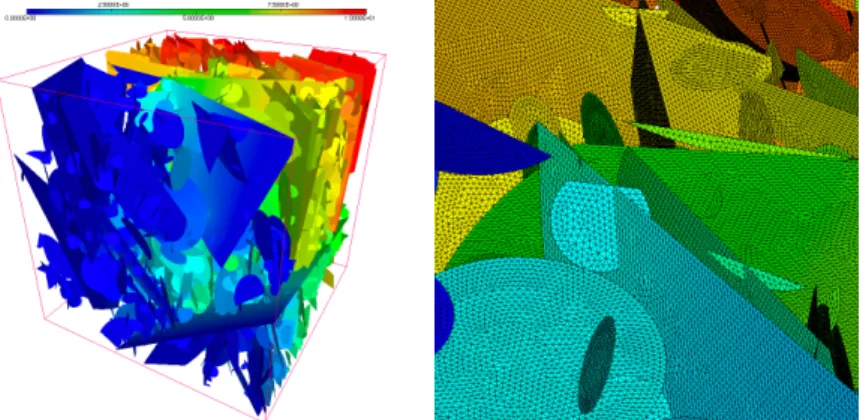HAL Id: hal-01896927
https://hal.inria.fr/hal-01896927
Submitted on 16 Oct 2018
HAL is a multi-disciplinary open access
archive for the deposit and dissemination of
sci-entific research documents, whether they are
pub-lished or not. The documents may come from
teaching and research institutions in France or
abroad, or from public or private research centers.
L’archive ouverte pluridisciplinaire HAL, est
destinée au dépôt et à la diffusion de documents
scientifiques de niveau recherche, publiés ou non,
émanant des établissements d’enseignement et de
recherche français ou étrangers, des laboratoires
publics ou privés.
Automatic meshing of Discrete Fracture Networks
Patrick Laug, Géraldine Pichot, Romain Le Goc, Caroline Darcel, Philippe
Davy
To cite this version:
Patrick Laug, Géraldine Pichot, Romain Le Goc, Caroline Darcel, Philippe Davy. Automatic meshing
of Discrete Fracture Networks. Computational Methods in Water Resources XXII (CMWR 2018),
Jun 2018, Saint-Malo, France. �hal-01896927�
Automatic meshing of Discrete Fracture Networks
Laug, Patrick, INRIA Saclay, France
Pichot, G´
eraldine, INRIA Paris, France
Le Goc, Romain, Itasca Consultants SAS, France
Darcel, Caroline, Itasca Consultants SAS, France
Davy, Philippe, University of Rennes 1, France
Key words: DFN, mesh generation, flow simulation
Introduction
DFN models may contain a large number of fractures, whose sizes span over several order of magnitudes. In addition, fracture intersections also have a wide range of sizes. Their influence is reinforced by the presence, in natural fractured media, of specific configurations like T-terminations that should be properly handled. The rock matrix is considered impervious here. The challenge is to build a mesh of the fractures with necessary quality for subsequent flow simulations. We require that the generated mesh:
• includes the fracture intersections and the highly critical T-terminations, whatever their size and position in the fracture plane,
• contains a relevant number of elements to accurately model the flow properties but which remains reason-able for the flow simulation to be feasible.
Presented work
We will present BLSURF FRAC software, which first builds a geometric model including fracture intersections. In a second phase, it generates a mesh of the geometric model by calling an associated planar mesher [1]. The general scheme is the following :
1. Compute the intersections of the disks and save topological information;
2. Split curves and find common extremities (for intersections and disks boundaries); 3. Build valid curve discretizations;
4. Generate a mesh of each planar disk, using a user-selected planar mesher, and create the final tridimen-sional mesh.
The first three steps are handled by BLSURF FRAC software. The main difficulty is to build valid curve dis-cretizations (step 3). To do so, BLSURF FRAC implements automatic corrections. As planar meshers (step 4), we propose to consider the two followings, BAMG and BL2D.
As benchmark test cases, we extend those proposed in [2, 3] to DFNs generated with the UFM framework [4, 5]. They are large scale DFNs where the fracture size distribution matches the observations and where fractures are organized so that large fractures inhibit the smaller ones, creating T-termination configurations. As illustration, we present the results on such a DFN, called DFNL50. Figure 1 shows this DFN, made of 3477 fractures, together with the meshes obtained with BAMG and BL2D respectively, using a constant mesh step.
Figure 1: (Left) DFNL50 Test case: 3477 fractures, 4334 intersections. Zoom on the mesh generated with: (middle) BAMG: #triangles: 1,513,802; (right) BL2D: #triangles: 1,450,993.
BL2D also has the abibility to adaptively refine the mesh, for more accurate and less expensive flow com-putations. As an example, figure 2 illustrates, for the same network, DFNL50, a mesh refinement around the intersections, with a significant reduction of the number of triangles, by comparison with the number of triangles obtained with a constant mesh step generation (as shown on Figure 1).
Figure 2: DFNL50 Test case - Adaptive mesh refinement with BLSURF - # triangles: 591,117.
Finally, we will also present the results of steady-state single phase flow solutions on different benchmark test cases. Figure 3 shows the flow solution, for a permeameter test case, on the network DFNL50 meshed with BLSURF FRAC combined with BL2D.
Figure 3: (Left) Mean hydraulic head computed on the network DFNL50. (Right) Zoom on the conforming mesh generated by BLSURF, #triangles: 5,924,391.
References
[1] H. Borouchaki, P. Laug, P.L. George. Parametric surface meshing using a combined advancing-front – generalized-Delaunay approach. International Journal for Numerical Methods in Engineering, 49 (1-2), 233–259 (2000). [2] P. Laug, G. Pichot, J.R. de Dreuzy. Realistic geometric modeling of fracture networks. ADMOS (2017).
[3] de Dreuzy, J.R., Pichot, G., Poirriez, B., Erhel, J.: Synthetic benchmark for modeling flow in 3D fractured media. Computers & Geosciences 50, 59–71 (2013).
[4] P. Davy, R. Le Goc, C. Darcel, O. Bour, J.R. de Dreuzy and R. Munier. A likely universal model of fracture scaling and its consequence for crustal hydromechanics. Journal of Geophysical Research: Solid Earth, 115 (B10) (2010). [5] P. Davy, R. Le Goc and C. Darcel. A model of fracture nucleation, growth and arrest, and consequences for fracture
density and scaling. Journal of Geophysical Research: Solid Earth, 118 (4), 1393–1407 (2013).

